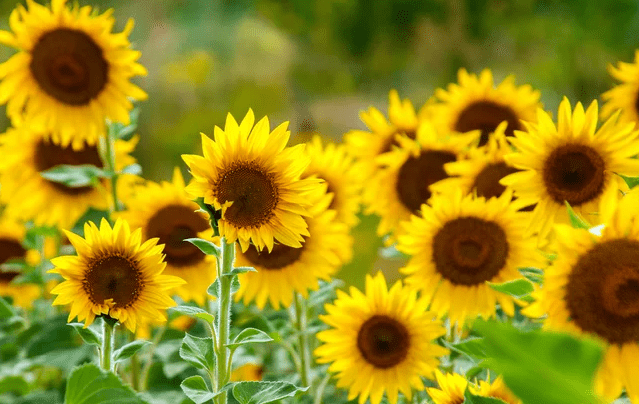
Description
Helianthus annuus, or sunflowers, are a summertime treasure. They can continue to bloom into early fall, usually starting in the middle of summer. The flowers have a broad central disc surrounded by short, yellow petals, and measure an average of 3 to 6 inches across. Sunflowers grow on a hairy, strong, upright stem that can be several feet high. The stems can bear a single flower or be branching with several blooms. Along the stem are arranged in rough, hairy, oval to triangular leaves. Since these blooms grow to maturity in just one year, they are considered annuals.
Habitat
Primarily indigenous to North and South America, several varieties of sunflowers are grown as ornamentals due to their impressive size and clusters of flowers, as well as their edible seeds. The edible underground tubers of the Jerusalem artichoke (Helianthus tuberosus) are the reason it is grown.
Uses
Europeans have used sunflower seeds medicinally for a variety of diseases. For example, pulmonary affections have been treated with sunflower seeds; a preparation of the seeds has been widely used for colds and coughs; in the Caucasus, quinine has been replaced with sunflower seeds in the treatment of malaria; and sunflower seeds are diuretic and expectorant. The Portuguese utilized sunflower pith to make moxa, a substance used to cauterize wounds and illnesses. Fly killing has been done with an infusion made from the flowers.

Varieties
- Helianthus annuus ‘Russian Giant’
- Helianthus annuus ‘Teddy Bear’
- Helianthus annuus ‘Giant Sungold’
- Helianthus annuus ‘Autumn Mix’
- Helianthus annuus ‘Italian White’
Plant Care
- Light
Plant your sunflowers in full sun, which is defined as at least six hours of direct sunshine per day, for the best flowering and strongest stems. Sunlight exposure helps sunflowers stay straight instead of bending in the direction of the greatest light because they are heliotropic, meaning that their flower heads follow the sun.
- Soil
Sunflowers may be grown in nearly any type of soil, even dry, poor soil. But they do best in soil that drains properly and has a healthy dose of organic matter.
- Water
Sunflowers can withstand harsh circumstances, but regular watering encourages blooming because blossoming frequently decreases during dry spells. In between waterings, let the top one to two inches of soil dry out. Your sunflowers probably need extra water if they are drooping and the soil is dry.
- Temperature and Humidity
Sunflowers thrive best at temperatures between 70 and 78 degrees Fahrenheit. As long as they have the moisture they require, they can still withstand intense heat. Sunlight and a little bit of cold are good for sunflowers. Although they can withstand high humidity levels, they need soil that drains well and adequate air circulation to avoid problems like root rot.
- Fertilizer
A high-phosphorus and potassium fertilizer is beneficial to sunflowers. Rich, loamy soil usually eliminates the need for additional fertilizer. However, if your soil is poor, start applying a slow-release fertilizer in the spring and follow the directions on the label. Be careful not to overfeed your plants because this might lead to stiff stalks.
Table





